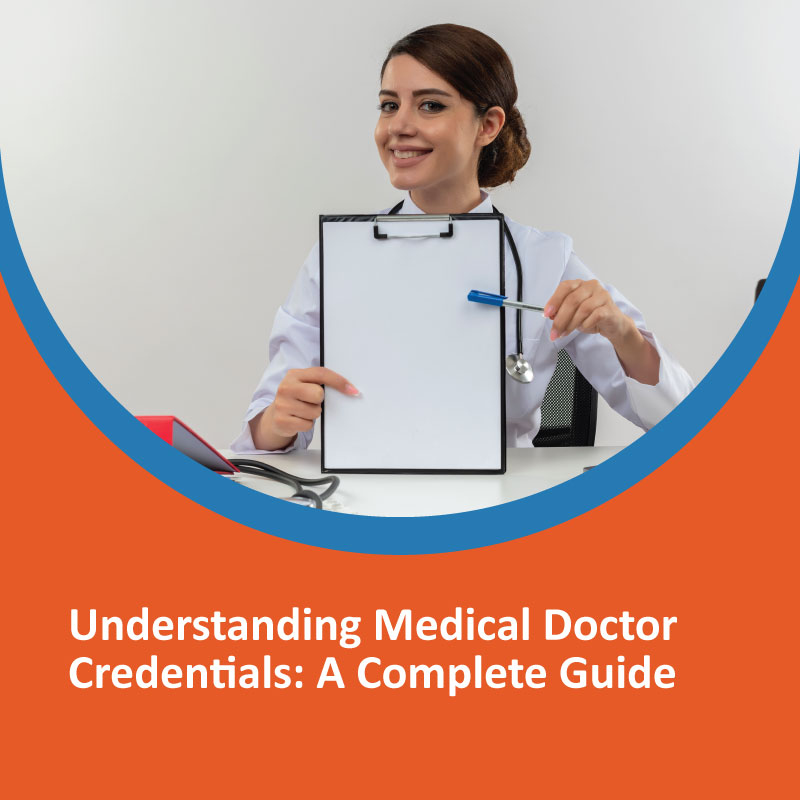Medical doctor credentials are more than just titles; they represent a combination of rigorous education, hands-on training, licensing exams, and ongoing certifications. These credentials ensure that a physician is qualified to diagnose, treat, and care for patients with professionalism and medical accuracy. When selecting a healthcare provider, understanding these credentials can help patients make informed decisions about their health.
To become a licensed physician, the journey begins with a bachelor’s degree, typically in a science-related field. Afterward, aspiring doctors must complete four years of medical school to earn either an MD (Doctor of Medicine) or DO (Doctor of Osteopathic Medicine). This foundational stage is essential in developing a strong understanding of human anatomy, medical ethics, pharmacology, and clinical procedures.
You may read: Medical Insurance Credentialing: A Complete Guide for Healthcare Providers
Following medical school, the next critical step in obtaining medical doctor credentials is the completion of a residency program. This hands-on training can last between 3 to 7 years, depending on the specialty. During residency, doctors work under supervision in hospitals and clinics, gaining experience in real-life medical environments. It’s a pivotal period where medical graduates translate their academic knowledge into practical skills.
The Role of Medical Licensing in Doctor Credentials
Medical licensing is a legal requirement to practice medicine in any state or country. In the U.S., MDs must pass the United States Medical Licensing Examination (USMLE), while DOs take the Comprehensive Osteopathic Medical Licensing Examination (COMLEX-USA). These exams are structured in multiple steps and test a candidate’s ability to apply knowledge, concepts, and patient care principles.
Licensing boards in each state verify a doctor’s education, exam performance, and background before granting a license. It’s important to note that licenses must be renewed periodically, and many states require proof of continuing medical education (CME) to maintain licensure. This ensures that doctors stay up to date with the latest advancements in medicine.
Board Certification and Specialization
Beyond licensing, many physicians pursue board certification in a specialty such as cardiology, dermatology, or internal medicine. To become board-certified, a doctor must complete additional training and pass rigorous examinations administered by a recognized medical board, such as the American Board of Medical Specialties (ABMS) or the American Osteopathic Association (AOA).
Board certification is a mark of excellence that showcases a doctor’s commitment to a specific field of practice. Although not mandatory for all practicing physicians, it adds a layer of trust and demonstrates deep expertise in a particular area of medicine. Patients often look for this credential when seeking specialized care.
Continuing Education and Credential Maintenance
Medical science evolves continuously, and it’s vital for physicians to keep pace with changes. Many licensing and certification boards require doctors to engage in ongoing education. This can include attending workshops, conferences, online courses, and passing periodic assessments. Such activities ensure that doctors continue to offer safe, effective, and evidence-based care throughout their careers.
Doctors who wish to maintain their medical doctor credentials must adhere to strict ethical standards and keep their knowledge current. This ongoing commitment safeguards patient health and reinforces trust in the healthcare system.
Importance of Verifying Doctor Credentials
Patients can verify a doctor’s credentials using various online resources. Websites like the Federation of State Medical Boards (FSMB), state licensing boards, and board certification databases allow users to check a doctor’s license status, certifications, and disciplinary history. This transparency is crucial in fostering confidence and making well-informed choices regarding medical care.
Conclusion
Medical doctor credentials reflect a physician’s academic achievements, practical training, and commitment to excellence. From earning a medical degree to passing licensing exams and obtaining board certification, each credential marks a significant milestone in a doctor’s career. For patients, these credentials provide assurance of competence, professionalism, and dedication to quality care. Whether choosing a primary care physician or a specialist, understanding these qualifications can help ensure you are in capable hands.
FAQs about Medical Doctor Credentials
Q1. What are medical doctor credentials?
Medical doctor credentials include degrees, licenses, board certifications, and ongoing training that prove a doctor’s qualification to practice medicine.
Q2. What is the difference between MD and DO?
An MD (Doctor of Medicine) follows allopathic medicine, while a DO (Doctor of Osteopathic Medicine) includes a holistic approach and osteopathic manipulative treatment.
Q3. How can I check a doctor’s credentials?
You can verify a doctor’s credentials through state medical boards, the Federation of State Medical Boards (FSMB), or board certification websites.
Q4. Is board certification required to practice medicine?
No, board certification is optional but highly recommended. It shows advanced expertise in a specific medical field beyond basic licensing.
Q5. Do doctors need to renew their credentials?
Yes, medical licenses and board certifications must be renewed regularly. Doctors also need to complete continuing education to maintain them.


